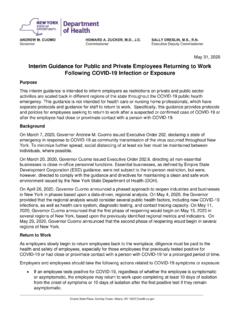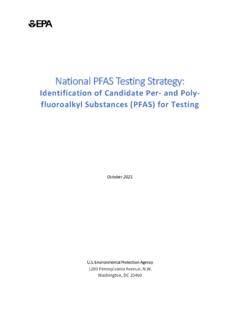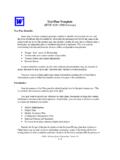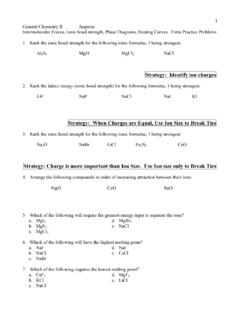Transcription of HEALTH ADVISORY: DISCONTINUATION OF HOME …
1 ANDREW M. CUOMO Governor HOWARD A. ZUCKER, , Commissioner LISA J. PINO, , Executive Deputy Commissioner Empire State Plaza, Corning Tower, Albany, NY 12237 Summary This guidance supersedes the previous NYSDOH HEALTH Advisory: Symptom-Based strategy to Discontinue Home Isolation for Persons with COVID-19 (May 30, 2020). NYSDOH continues to recommend a symptom-based strategy for determining the duration of isolation specifically, that a person may be released from isolation 10 days after illness onset, provided that symptoms are improving and they are fever-free without the use of fever-reducing medication. The period a person must be fever-free without the use of fever-reducing medication prior to discontinuing isolation has been reduced from 72 hours to 24 hours, consistent with CDC recommendations.
2 If a test-based strategy is used to determine DISCONTINUATION of isolation ( , for severely immunocompromised persons, or to end isolation earlier than determined by the symptom-based strategy ), negative results using RT-PCR for detection of SARS-CoV-2 RNA under an FDA Emergency Use Authorization (EUA) for COVID-19 from at least two consecutive respiratory specimens collected 24 hours apart (a total of two negative specimens) are required. Isolation must continue until all final laboratory results are available. This guidance applies to all individuals who test positive, irrespective of vaccination status. Background Accumulating evidence supports ending isolation and precautions for persons with laboratory-confirmed COVID-19 using a symptom-based strategy .
3 This update incorporates recent evidence to inform the duration of isolation and the precautions recommended to prevent transmission of SARS-CoV-2, while limiting prolonged isolation and the use of laboratory testing resources. This guidance supersedes previous NYSDOH guidance (Symptom-Based strategy to Discontinue Home Isolation for Persons with COVID-19, dated May 30, 2020) and is consistent with most recent CDC guidance (Interim Guidance on Duration of Isolation and Precautions for Adults with COVID-19, updated Feb. 13, 2021, and DISCONTINUATION of Isolation for Persons with COVID-19 Not in Healthcare Settings, updated Feb. 18, 2021). This guidance applies to persons who are directed to recover from COVID-19 at home or at another home-like setting ( , a hotel or dorm room).
4 This guidance is not intended, and separate guidance should be followed, for persons recovering from COVID-19 who are HEALTH ADVISORY: DISCONTINUATION OF HOME ISOLATION FOR PERSONS WITH COVID-19 WHO ARE NOT IN HEALTH CARE FACILITIES OR CONGREGATE SETTINGS July 23, 2021 2 hospitalized or reside in nursing homes, adult care facilities, or other congregate settings with vulnerable residents. Discontinuing home isolation for asymptomatic persons or symptomatic persons who are recovering from COVID-19 at home: NYSDOH continues to recommend a symptom-based strategy for determining the duration of isolation and precautions. Isolation may be discontinued under the following conditions: o At least 24 hours have passed since the last fever has resolved without the use of fever-reducing medications, AND o Symptoms (if present) have improved, AND o At least 10 days have passed since symptoms attributed to COVID-19 first appeared.
5 For persons who were asymptomatic at the time of their first positive test and who remained asymptomatic throughout their infection, at least 10 days have passed since the date of collection of the first positive test. For persons who were asymptomatic at the time of their first positive test and subsequently developed symptoms attributed to COVID-19, at least 10 days have passed since the date of symptom onset in addition to the clinical criteria above. Note that a limited number of persons who are severely ill or severely immunocompromised1 may produce replication-competent SARS-CoV-2 up to 20 days after illness onset. A test-based strategy (see below) can be considered for these persons to determine whether release from isolation and precautions is appropriate after 10 days.
6 Consultation with infectious diseases specialists is recommended. Use of RT-PCR testing (test-based strategy ) for discontinuing home isolation or precautions: The test-based strategy should be considered for severely immunocompromised1 individuals if concern exists that they might remain infectious more than 20 days, in consultation with infectious disease specialists. For all other persons ( , those with mild to moderate COVID-19) who are recovering at home, NYSDOH recommends the symptom-based strategy over the test-based strategy for release from isolation. This is because use of the test-based strategy could extend the period of isolation beyond the time required to prevent transmission due to prolonged shedding of virus that cannot replicate or shedding of RNA, which can cause persistently positive viral assay results.
7 Testing using an FDA-authorized molecular viral assay for detection of SARS-CoV-2 RNA can be used to discontinue isolation or other precautions earlier than would occur under the symptom-based strategy . However, because of the frequency of prolonged test positivity, the utility of this approach is limited. All of the following are required to discontinue home isolation and precautions using the test-based strategy : o At least 24 hours have passed since last fever, without the use of fever-reducing medications; AND 3 o Symptoms (if present) have improved; AND o Results are negative from at least two consecutive respiratory specimens collected greater than or equal to 24 hours apart and tested using an FDA-authorized molecular viral assay for detection of SARS-CoV-2 RNA (antigen tests are not molecular viral assays and should not be used for this purpose); AND o All final laboratory results must be available before isolation is ended.
8 NOTE: Persons who are released from isolation early based on two negative molecular viral tests performed as part of the test-based strategy are still considered to be cases. The initial positive test should not be considered a false positive, and the person with COVID-19 should be considered infectious until they have met symptom-based or test-based criteria for release from isolation. Contacts should quarantine for 10 days based on the last date of exposure, just as they would do for cases who are not released early. o The test-based strategy as described above should not be confused with situations that might occur when following the algorithms for interpreting antigen test results, when in certain conditions an antigen test might be determined to be a false positive.
9 Guidance regarding isolation can be found here. For More Information CDC DISCONTINUATION of Isolation for Persons with COVID-19 Not in Healthcare Settings: Interim Guidance CDC Interim Guidance on Duration of Isolation and Precautions for Adults with COVID-19 NYSDOH Revised DISCONTINUATION of Transmission-Based Precautions for Patients with COVID-19 Who Are Hospitalized or in Nursing Homes, Adult Care Facilities, or Other Congregate Settings with Vulnerable Residents Footnote 1 CDC defines severely immunocompromised as below but notes that the degree of immunocompromise is ultimately determined by the treating provider. Additional information is available at #definitions: Being on chemotherapy for cancer; Hematologic malignancies; Being within one year out from receiving a hematopoietic stem cell or solid organ transplant; Untreated HIV infection with CD4 T-lymphocyte count <200; Combined primary immunodeficiency disorder; or Taking immunosuppressive medications, , drugs to suppress rejection of a transplanted organ or treat a rheumatologic condition (such as mycophenolate or rituximab), receipt of prednisone >20 mg/day for >14 days.
10
















